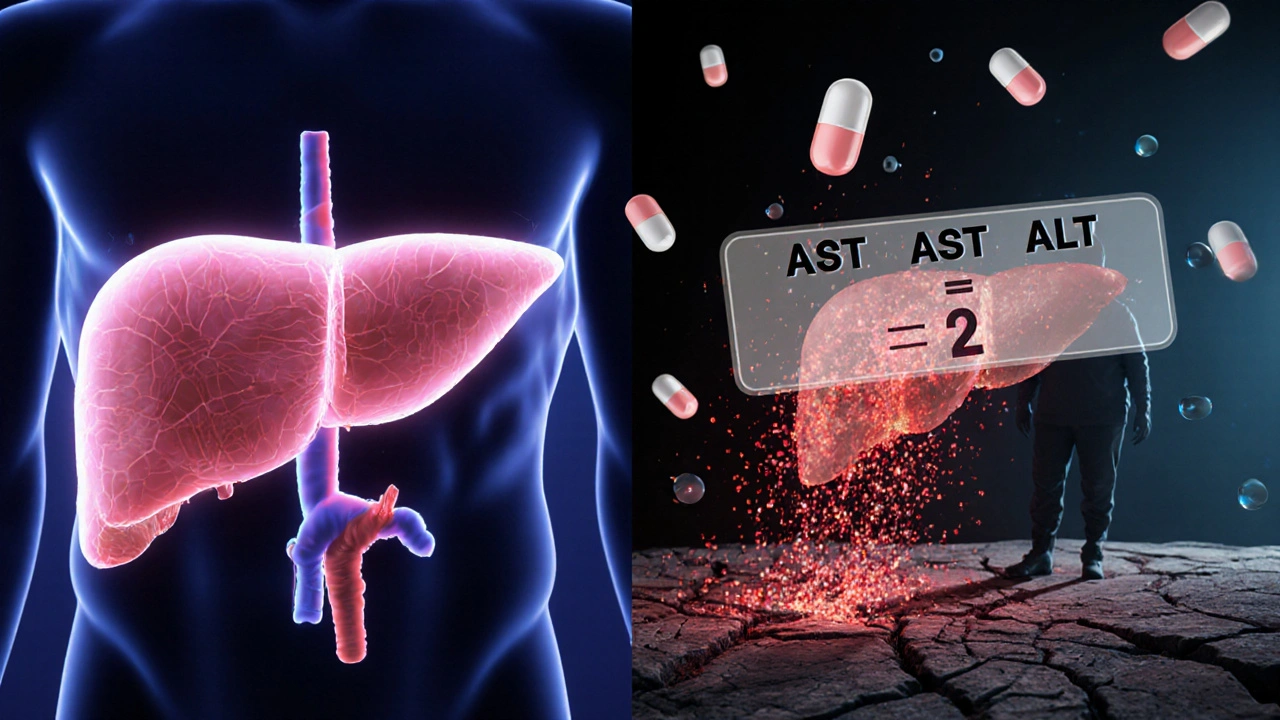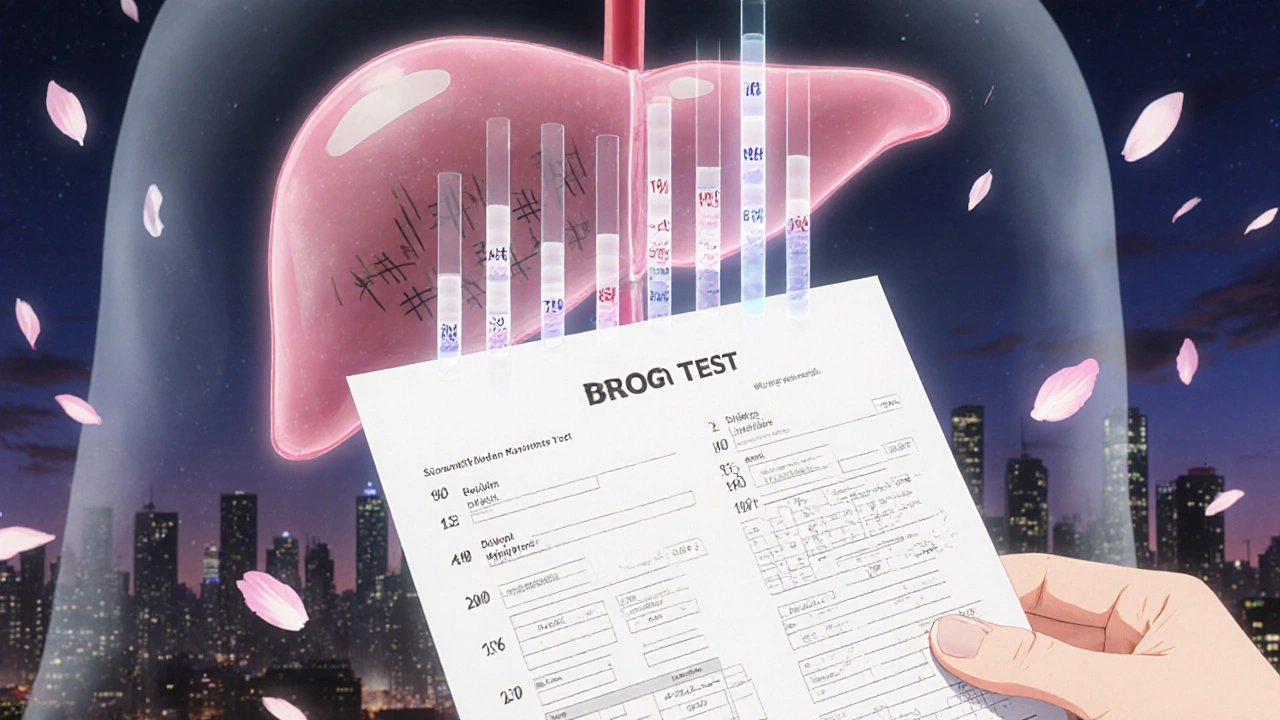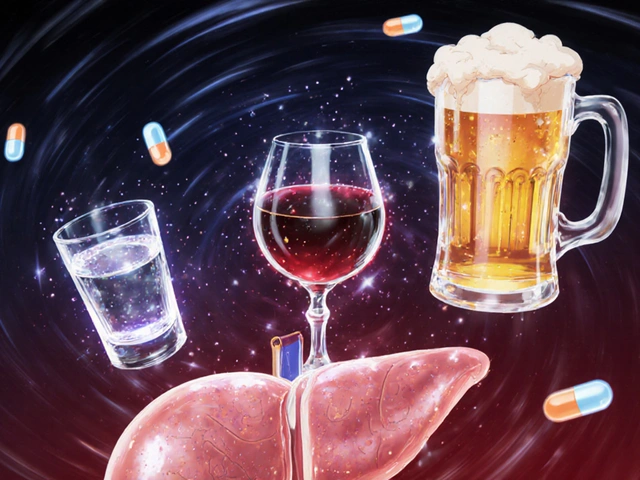When your doctor orders liver function tests, they’re not checking how well your liver is working like a machine. They’re looking for signs it’s been damaged. The term ‘liver function tests’ is misleading-most of these blood markers don’t measure function at all. They measure leakage. When liver cells get injured, enzymes and pigments spill into the bloodstream. That’s what shows up on your lab report.
What’s Actually Measured in a Liver Panel?
A standard liver panel includes five key markers: ALT, AST, ALP, bilirubin, and albumin. Sometimes GGT and prothrombin time are added. Each tells a different story.
- ALT (alanine aminotransferase): Almost entirely found in liver cells. When liver cells die, ALT pours into the blood. It’s the most specific marker for liver injury.
- AST (aspartate aminotransferase): Found in liver, heart, muscles, and kidneys. Less specific than ALT. A high AST can mean liver damage-but it could also mean a heart attack or intense workout.
- ALP (alkaline phosphatase): Elevated when bile flow is blocked. Comes from liver and bones. If ALP is high but GGT is normal, it might be a bone issue, not liver.
- Bilirubin: A yellow pigment made when red blood cells break down. The liver processes it and sends it out in bile. High levels cause jaundice. Total bilirubin is split into direct (conjugated) and indirect (unconjugated) to figure out why it’s up.
- Albumin: Made by the liver. Low levels mean the liver isn’t making proteins anymore-usually a sign of long-term damage, not sudden injury.
Reference ranges vary by lab, but general normal values are: ALT 7-55 U/L, AST 8-48 U/L, total bilirubin 3-17 μmol/L, albumin 35-50 g/L. But here’s the catch: normal doesn’t always mean healthy.
Why ALT and AST Don’t Tell the Whole Story
Many people panic when their ALT is 60 U/L. But 10-15% of healthy people have ALT levels slightly above normal. Obesity, intense exercise, or even a recent binge drinking episode can nudge it up without causing disease.
What matters is the pattern. Two numbers tell you more than five:
- ALT > AST: This is the classic sign of viral hepatitis, fatty liver (now called MASLD), or drug-induced injury. In acute hepatitis A or B, ALT can spike 10 times above normal.
- AST > ALT: Especially if AST is twice as high as ALT? That’s a red flag for alcohol-related liver damage. In alcoholic hepatitis, AST often runs 2-6 times above normal, while ALT only climbs 1-2 times. The ratio is so reliable that over 90% of alcoholic hepatitis cases show AST:ALT > 1.
- AST > 500 U/L: If you’re a heavy drinker and your AST is this high, it’s probably not just alcohol. Think acetaminophen overdose.
ALT has a half-life of about 47 hours. That means if you had an acute injury-like a viral infection or drug reaction-ALT will stay elevated for days, even after you feel better. AST clears faster. So if ALT is still high after a week, the liver is still under stress.
Bilirubin: The Yellow Clue
Bilirubin doesn’t rise in most liver injuries. It only goes up when bile flow is blocked or the liver can’t process it. That’s called cholestasis.
If bilirubin is high and ALP is also high (3x or more), you’re looking at a bile duct problem: gallstones, tumors, or medication side effects. If bilirubin is high but ALP is normal? That’s usually a problem with red blood cell breakdown (hemolysis) or inherited conditions like Gilbert’s syndrome.
Direct bilirubin (conjugated) being high means the liver processed it but couldn’t get it out. Indirect bilirubin high? The liver isn’t processing it fast enough. A simple split tells you where the problem lies.

Albumin and Prothrombin Time: The Real Function Tests
These are the only two markers that actually measure what the liver does: make proteins and help blood clot.
Albumin has a half-life of 20 days. So if your albumin is low, your liver has been struggling for weeks or months. It’s not a sign of a sudden problem. Low albumin shows up in advanced cirrhosis, chronic alcohol use, or severe malnutrition.
Prothrombin time (PT) is more sensitive. It measures how fast your blood clots. The liver makes clotting factors that need vitamin K. If PT is prolonged, it means the liver is failing to make those proteins quickly. This can happen in days during acute liver failure. A rising PT is one of the most serious signs a liver is shutting down.
When Do You Worry? When Do You Wait?
Not every elevated liver test needs a CT scan or biopsy.
- Mild elevations (ALT/AST under 2x normal): Watch and repeat in 3-6 months. This is common in people with obesity, prediabetes, or occasional alcohol use. Lifestyle changes often fix it.
- Moderate elevations (2-5x normal): Look for causes: alcohol, medications (including herbal supplements), viral hepatitis, or fatty liver. Get tested for hepatitis B and C. Check your BMI and blood sugar.
- Severe elevations (above 500 U/L): This is urgent. Could be acute viral hepatitis, drug toxicity (especially acetaminophen), or ischemic injury. Don’t wait. Go to the ER.
- Isolated ALP elevation: If GGT is normal, check for bone disease. Ask about bone pain or fractures.
A 2022 JAMA study found that nearly 4 out of 10 primary care doctors ordered unnecessary imaging for ALT levels between 41-80 U/L. That’s not just wasteful-it causes anxiety. Most of those people had no liver disease.

What’s Missing? Fibrosis, Not Just Inflammation
Two people can have the same ALT level. One has mild fatty liver. The other has advanced scarring (fibrosis). The test can’t tell the difference.
That’s why experts now combine LFTs with non-invasive scores like FIB-4. FIB-4 uses age, ALT, AST, and platelet count to estimate liver scarring. A 2021 Hepatology study showed that adding FIB-4 to LFTs raised the accuracy of detecting advanced fibrosis from 68% to 89%.
Future tools like the ELF test (enhanced liver fibrosis) measure three proteins linked to scarring. In 2024, a Lancet study showed it detects severe fibrosis with 92% accuracy when combined with AST/ALT ratio.
What to Do Next
If your liver tests are off:
- Stop alcohol completely for at least 4 weeks. Retest.
- Review all medications and supplements-even ‘natural’ ones. Some herbs like kava, green tea extract, and high-dose niacin can hurt the liver.
- Check your weight and blood sugar. Fatty liver is the #1 cause of elevated ALT in adults today.
- Get tested for hepatitis B and C. Many people don’t know they have it.
- Don’t panic over mild elevations. But don’t ignore them either. Track them over time.
The liver is quiet until it’s almost broken. But if you catch problems early-before scarring sets in-you can often reverse the damage. Diet, exercise, and avoiding alcohol do more than any pill.
Can ALT be high without liver disease?
Yes. ALT can rise due to intense exercise, obesity, certain medications, or even a recent alcohol binge. Up to 15% of healthy people have slightly elevated ALT without any liver damage. The key is whether it stays high over time and if other markers are also abnormal.
Why is AST higher than ALT in alcoholics?
Alcohol damages liver cells differently than viruses or fatty liver. It causes mitochondrial damage, which releases more AST than ALT. Also, alcoholics often have low vitamin B6, which affects ALT production more than AST. This shifts the ratio, making AST twice as high as ALT-a classic sign of alcoholic liver disease.
Does a normal liver test mean my liver is healthy?
Not always. In early fatty liver or mild cirrhosis, ALT and AST can be normal. The liver can compensate for a long time. That’s why doctors look at other signs: belly fat, blood sugar, platelet count, and ultrasound. Normal blood work doesn’t rule out liver disease-it just means no major cell damage yet.
Can medications cause abnormal liver tests?
Yes. Common ones include statins, antibiotics like amoxicillin-clavulanate, anti-seizure drugs, and even high-dose acetaminophen. Herbal supplements like green tea extract, kava, and black cohosh are also known culprits. Always tell your doctor what you’re taking-even if you think it’s harmless.
What’s the difference between MASLD and NAFLD?
MASLD (Metabolic dysfunction-Associated Steatotic Liver Disease) is the new name for NAFLD (Non-Alcoholic Fatty Liver Disease). The change reflects a better understanding: it’s not just about avoiding alcohol-it’s about metabolic health. Insulin resistance, obesity, and high blood sugar are the real drivers. The liver pattern is the same: ALT higher than AST, often mild elevation.
How often should I get liver tests if I have fatty liver?
If you’ve been diagnosed with fatty liver and your tests are mildly elevated, get them checked every 6-12 months. Focus on weight loss (even 5-10% helps), exercise, and cutting sugar. If ALT drops, that’s a good sign. If it keeps rising or you develop symptoms like fatigue or swelling, see a specialist.









Comments (13)
Bill Camp
November 20, 2025 AT 00:04 AMSo let me get this straight - ALT is basically the liver’s scream when it’s being murdered by donuts and Zoom calls? 🤯 I’ve seen so many people panic over 60 U/L like it’s a death sentence. Meanwhile, their ‘healthy’ diet is just a protein shake and a bag of chips. The real villain? Metabolic syndrome. Not the lab report.
Pawan Jamwal
November 21, 2025 AT 05:34 AMIndia has the highest NAFLD cases in Asia and still doctors ignore it! 😤 My cousin’s ALT was 89 - he thought it was ‘just stress’ until his liver was 70% fat. Stop normalizing obesity! Eat roti, not rice syrup. Stop drinking beer after yoga. 🇮🇳 #LiverAwareness
Lemmy Coco
November 22, 2025 AT 16:44 PMwait so if alt is higher than ast its fatty liver? i always thought it was the other way around… maybe i read that wrong. also ggt is what now? lol. sorry im not a med student but this stuff is actually useful
rob lafata
November 23, 2025 AT 08:15 AMOh wow. So the medical establishment is just now realizing that ‘liver function tests’ don’t measure function? Groundbreaking. 🙄 Let’s not forget the 20 years of pharma ads pushing statins while ignoring that 80% of elevated AST/ALT cases are caused by sugar, not fat. The system is designed to keep you doc-shopping, not lifestyle-changing. You think your doctor cares? Nah. They’re paid to prescribe, not to preach.
Matthew McCraney
November 24, 2025 AT 18:42 PMThey’re hiding something. Why do all the ‘normal’ ranges keep changing? First it was 40, now it’s 55? Coincidence? I’ve seen patients with AST 300 and normal ultrasound. Then they get biopsied and find… nothing. But the liver’s ‘fine’? Bullshit. The CDC knows. The FDA knows. They’re letting Big Pharma control the narrative. You think glyphosate doesn’t mess with your mitochondria? Think again.
serge jane
November 25, 2025 AT 07:30 AMI’ve been reading about liver health for years now and what strikes me is how little we focus on the organ’s capacity to regenerate. It’s not just about the numbers - it’s about the context. A 28-year-old with ALT 70 who runs marathons and eats clean is not the same as a 52-year-old with ALT 70 who drinks two wines a night and has a waistline that defies gravity. The liver doesn’t lie - but we sure do when we reduce its story to a single digit.
Nick Naylor
November 26, 2025 AT 13:47 PMALT>AST: Fatty Liver. AST>ALT: Alcoholic. ALP+GGT: Cholestasis. Bilirubin: Conjugated vs. Unconjugated. Albumin: Chronic. PT: Acute Failure. FIB-4: Non-invasive Fibrosis. ELF: Emerging Biomarker. MASLD: New Terminology. ALL OF THIS IS CRITICAL. IF YOU DON’T KNOW THIS, YOU’RE NOT JUST UNINFORMED - YOU’RE A RISK TO YOURSELF AND OTHERS.
Brianna Groleau
November 26, 2025 AT 15:40 PMI used to think my liver was fine because I didn’t drink. Then I got my first blood test after losing 30 lbs and my ALT dropped from 82 to 38. I didn’t change my diet - I just stopped eating sugar. The liver is so forgiving if you give it half a chance. I wish more people knew that healing doesn’t require pills. It just requires honesty. And maybe a little less pizza.
Rusty Thomas
November 26, 2025 AT 20:39 PMOMG I just got my results and my AST is 78 and ALT is 50 and I’m crying 😭 I’ve been eating avocado toast every day and drinking kombucha like it’s holy water. Is this it? Am I dying? I’ve been so good!! Why is this happening to me?!? 😭😭😭 I need a therapist AND a hepatologist.
Sarah Swiatek
November 28, 2025 AT 08:12 AMLet’s be real - most people don’t need to know the difference between direct and indirect bilirubin. What they need is to hear: ‘Your liver is screaming for rest.’ No, you don’t need a CT scan. Yes, you need to stop drinking soda. No, your ‘detox tea’ isn’t helping. Yes, your 10,000-step walk is better than any supplement. The liver doesn’t care about your lab’s reference range. It cares about whether you’re giving it a break. So stop overcomplicating it. Just breathe. And put down the whiskey.
Dave Wooldridge
November 29, 2025 AT 02:50 AMDid you know the WHO is pushing this ‘MASLD’ thing to hide the fact that glyphosate in our food is frying livers? They changed the name so you won’t connect it to Roundup. They don’t want you to know that your organic kale smoothie has 3x more pesticide residue than your McDonald’s fries. And your ‘normal’ ALT? It’s because the labs lowered the range to make you think you’re fine. Wake up.
Rebecca Cosenza
November 29, 2025 AT 14:03 PMMy ALT was 58. I stopped alcohol. I lost 8 lbs. Retest: 32. Done. No drama. No scans. Just life changes. 💪
swatantra kumar
November 29, 2025 AT 16:28 PMBro I’ve been telling my cousins in Delhi this for years 😎 ALT > AST? Fatty liver. Drink less chai with sugar. Walk after roti. Your liver doesn’t need a pill - it needs a nap. 🤓🌿 #IndiaLiverRevolution